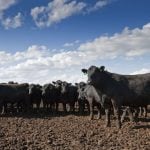“It is very important that we all continue to further educate ourselves on the variability of DDGS, the logistical restraints and performance benefits in livestock rations.”
Ryan Slozka
A British Columbia-based agricultural commodity trader has purchased a loading site in Montana to facilitate imports of dried distillers grains with
solubles (DDGS) into Canada. Rycom Trading Ltd. has
acquired a transloading facility in Sunburst, Montana to give Canadian livestock producers greater access to DDGS, a byproduct of ethanol production.
Read Also

Auctioneering runs in Lawes family’s blood
Casey Lawes of Provost, Alta., won the Livestock Markets Association of Canada’s Canadian Livestock Auctioneering Championship in Brandon, Man.
The facility, called Rycom Transload Services, is along
the Burlington Northern Santa Fe Railway seven miles south of
Alberta, home to Canada’s largest cattle-feeding industry.
It will give Canadian producers access to more DDGS manufacturers while eliminating total reliance on the Canadian Pacific Railway, company representative Ryan Slozka said in a statement.
Canada is the second-largest export market for DDGS from the U. S., last year importing 804,000 tonnes. It’s expected Canada’s purchases of U. S. DDGS will increase in 2010 as buyers become more aware about the product, according to industry experts.
Three to four years ago, Canadian livestock producers fed a maximum of 10 per cent DDGS in their rations. Today, DDGS content in rations ranges from 15 per cent to as high as 30 per cent, according to the U. S. Grains Council.
“Fifteen per cent and 20 per cent inclusion is the average,” said Neil Campbell, a USGC consultant in Canada. “But nutritionists are using results from trials and on-farm experiences to demonstrate that DDGS inclusion rates at higher levels will lower their feed costs.”
DDGS is becoming price-competitive with barley, according to Slozka. He said DDGS is currently trading at 105 per cent of Canadian barley, whereas in 2009 it was over 120 per cent until settling back after July.
Notwithstanding the nutritive value of DDGS, Slozka emphasized producers exercise caution in using it.
“It is very important that we all continue to further educate ourselves on the variability of DDGS, the logistical restraints and performance benefits in livestock rations.”














